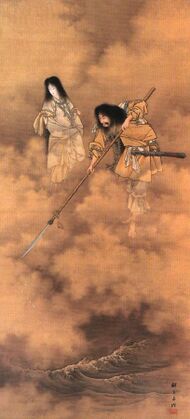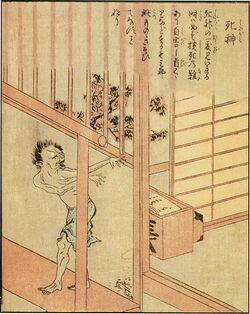Unsolved:Shinigami
Script error: The function "transl" does not exist. (Japanese: 死神, lit. 'Script error: The function "transl" does not exist. of death') are Script error: The function "transl" does not exist. that invite humans toward death in certain aspects of Japanese religion and culture. Script error: The function "transl" does not exist. have been described as monsters, helpers, and creatures of darkness. Script error: The function "transl" does not exist. are used for tales and religions in Japanese culture.[1][2]
Japanese religion
In Buddhism, there is the Mara that is concerned with death, the Mrtyu-mara.[3] It is a demon that makes humans want to die, and it is said that upon being possessed by it, in a shock, one should suddenly want to die by suicide, so it is sometimes explained to be a Script error: The function "transl" does not exist..[4] Also, in the Yogacarabhumi-sastra, a writing on Yogacara, a demon decided the time of people's deaths.[5] Yama, the king of the Underworld, as well as Script error: The function "transl" does not exist. such as the Ox-Head and Horse-Face are also considered a type of Script error: The function "transl" does not exist..[1]
In Shinto and Japanese mythology, Izanami gave humans death, so Izanami is sometimes seen as a Script error: The function "transl" does not exist..[1][2] However, Izanami and Yama are also thought to be different from the death gods in Western mythology.[5][6] Some forms of Buddhism do not involve believing in any deities, so it is sometimes thought that the concept of a death god does not exist to begin with.[5] Even though the Script error: The function "transl" does not exist. and Script error: The function "transl" does not exist. of Japanese Buddhist faith have taken humans' lives, there is the opinion that there is no "death god" that merely leads people into the world of the dead.[6] After the war[clarification needed], however, the Western notion of a death god entered Japan, and Script error: The function "transl" does not exist. started to become mentioned as an existence with a human nature.[5]
Script error: The function "transl" does not exist.
Generally, the word Script error: The function "transl" does not exist. does not appear to be used in Japanese classical literature, and there are not many writings about them;[7] however, going into the Edo period, the word Script error: The function "transl" does not exist. can be seen in Chikamatsu Monzaemon's works of Script error: The function "transl" does not exist. and classical literature that had themes on double suicides.
In Hōei 3 (1706), in a performance of Script error: The function "transl" does not exist., concerning men and women who were invited towards death, it was written "the road the god of death leads towards",[8] and in Hōei 6 (1709), in Script error: The function "transl" does not exist., a woman who was about to commit double suicide with a man said, "the fleetingness of a life lured by a god of death".[9] It never became clear whether the man and woman came to commit double suicide due to the existence of a Script error: The function "transl" does not exist., or if a Script error: The function "transl" does not exist. was given as an example for their situation of double suicide,[1] and there are also interpretations that the word Script error: The function "transl" does not exist. is an expression for the fleetingness of life.[10]
Other than that, in Kyōhō 5 (1720), in a performance of The Love Suicides at Amijima, there was the expression, "of one possessed by a god of death". Since the character was seller of paper, the character who confronted death wrote "paper" (紙 kami) as "god" (神 kami),[11][12] but there are also interpretations that Chikamatsu himself did not think about the existence of a Script error: The function "transl" does not exist..[1]
Classical literature
In the classical literature of the Edo period, Script error: The function "transl" does not exist. that would possess humans are mentioned. In the Script error: The function "transl" does not exist. from Tenpō 12 (1841), there was a story titled Script error: The function "transl" does not exist.. In this one, however, the Script error: The function "transl" does not exist. was the spirit of a deceased person and had bad intent. Acting jointly with the malicious intent already within people who were living, those people were led on bad paths, which caused repeat incidents to occur at places where there was previously a murder incident (for example by causing the same suicide at places where people have hanged themselves before),[13] and thus these Script error: The function "transl" does not exist. are somewhat like a possession that would cause people to want to die.[7][14][clarification needed] Similar to this, according to the essay of the Bakumatsu period titled Script error: The function "transl" does not exist., there were the Script error: The function "transl" does not exist. that made people want to commit suicide through various means, namely hanging, as well as things told through folk religion such as Script error: The function "transl" does not exist. and Script error: The function "transl" does not exist..[5]
In the later Edo Period, the essay Script error: The function "transl" does not exist. in Kaei 3 (1850) by the essayist Miyoshi Shōzan, the one titled "upon possession by a shinigami, it becomes difficult to speak, or easier to tell lies" was a story where a prostitute possessed by a Script error: The function "transl" does not exist. invites a man to commit double suicide,[15][16] and in the kabuki Script error: The function "transl" does not exist. by Kawatake Mokuami in Meiji 19 (1886), a Script error: The function "transl" does not exist. enters into people's thoughts, making them think about bad things they have done and want to die.[17] These are, rather than gods, more like Script error: The function "transl" does not exist. (meaning ghosts and Script error: The function "transl" does not exist.),[18] or evil spirits.[1]
In the Script error: The function "transl" does not exist. of classical Script error: The function "transl" does not exist., there was a programme titled Script error: The function "transl" does not exist., but this was something that was not thought of independently in Japan, but rather from adaptions of the Italian opera the Crispino e la comare[19] and the Grimm Fairy Tale "Godfather Death".[20]
Folk religion
Script error: The function "transl" does not exist. are also spoken about in folk religion after the war. According to the mores of Miyajima, Kumamoto Prefecture, those who go out and return to attend to someone through the night must drink tea or eat a bowl of rice before sleeping, and it is said that a Script error: The function "transl" does not exist. would visit if this was ignored.[21]
In the Hamamatsu area, Shizuoka Prefecture, a Script error: The function "transl" does not exist. would possess people and lead them to mountains, seas, and railroads where people have died. In those places, the dead would have a "death turn" (Script error: The function "transl" does not exist.), and as long as there is nobody to die there next, they shall never ascend even if they were given a service, and it was said that people who were alive would be invited by the dead to come next.[15] Also, it is ordinary to visit graves for the sake of Higan during noon or when the sun sets, but in the Okayama Prefecture, visiting the grave for Higan during sunrise without a previous time would result in being possessed by a Script error: The function "transl" does not exist.. However, once one has visited the grave in sunset, then it would become necessary to visit the grave again during sunrise, to avoid a Script error: The function "transl" does not exist. possessing one's body.[15] With this background of folk belief, it is also thought that sometimes people would consider the ghosts of the deceased, who have nobody to deify them, to be seeking companions and inviting people to join them.[15]
See also
- Death (personification) - personifications of death
- Psychopomp - any entity that guides the souls of the dead to the afterlife
- Ankou - the equivalent in Celtic mythology
- Azrael - the angel of death in Abrahamic religions
- Script error: The function "transl" does not exist. - Chinese angels of death
- Kṣitigarbha - Bodhisattva of hell-beings
- Thanatos - the god of death in Greek mythology
- King Yama - judge of the dead who presides over Narakas
- Yanluo Wang - ruler of Youdu
Notes
- ↑ 1.0 1.1 1.2 1.3 1.4 1.5 七会 2009, pp. 168–193
- ↑ 2.0 2.1 河野信子編 (1995). 女と男の時空. 1. 藤原書店. p. 115. ISBN 978-4-89434-022-0.
- ↑ 中村元 (2001). 広説佛教語大辞典. 中巻. 東京書籍. p. 720. ISBN 978-4-487-73177-0.
- ↑ 大栗道栄 (1997). 図説「理趣経」入門 密教の核心. 鈴木出版. p. 101. ISBN 978-4-7902-1074-0.
- ↑ 5.0 5.1 5.2 5.3 5.4 多田 1997, pp. 127–128
- ↑ 6.0 6.1 木村 2007, p. 141
- ↑ 7.0 7.1 村上 2005, pp. 166–167
- ↑ 鳥越他訳 1998, p. 76.
- ↑ 鳥越他訳 1998, p. 266.
- ↑ スズキトモユ (2005-07-04). "日刊! ニュースな本棚". エキサイト. http://media.excite.co.jp/book/daily/monday/010/.
- ↑ 鳥越他訳 1998, p. 424.
- ↑ "近松の世話浄瑠璃". 日本芸術文化振興会. 2010. http://www2.ntj.jac.go.jp/dglib/contents/learn/edc13/jidai/sewajoruri/p1.html.
- ↑ 桃山人 (2006). 桃山人夜話 絵本百物語. 角川ソフィア文庫. 角川書店. p. 131. ISBN 978-4-04-383001-5.
- ↑ 村上 2000, p. 69
- ↑ 15.0 15.1 15.2 15.3 大藤他 1986, p. 100
- ↑ 三好想山 (1970). "想山著聞奇集". in 谷川健一 他編. 日本庶民生活史料集成. 第16巻. 三一書房. pp. 81–83. NCID BN02048386.
- ↑ 河竹黙阿弥 (1970). 河竹黙阿弥集. 名作歌舞伎全集. 第12巻. 戸板康二 他監修. 東京創元新社. pp. 218. ISBN 978-4-488-02512-0.
- ↑ 松村明 編 (2006). 大辞林 (第3版 ed.). 三省堂. pp. 2579. ISBN 978-4-385-13905-0.
- ↑ 永井啓夫 (2011). 三遊亭円朝. 青蛙選書 (新装版 ed.). 青蛙房. pp. 271–272. ISBN 978-4-7905-0875-5.
- ↑ 北村正裕 (August 2000). "死神のメルヘン グリム童話と日本の落語". 駿台フォーラム (第18号): 54–68. NCID AN10084875.
- ↑ 八木三二 (July 1933). "熊本県宮地町地方". 旅と伝説 (第6年7月号): 178. NCID AN00139777.
References
- 大藤時彦 他 (1986). 相賀徹夫 編. ed. 日本大百科全書. 第11巻. 小学館. ISBN 978-4-09-526011-2.
- 木村文輝 (2007). 生死の仏教学. 法藏館. ISBN 978-4-8318-2418-9.
- 多田克己 (1997). "『絵本百物語』の妖怪たち". 絵本百物語 桃山人夜話. 国書刊行会. ISBN 978-4-336-03948-4.
- 近松門左衛門 (1998). 近松門左衛門集. 新編日本古典文学全集. 2. 鳥越文蔵 他校中・訳. 小学館. ISBN 978-4-09-658075-2.
- 七会静 (2009). よくわかる「世界の死神」事典. 廣済堂文庫. 廣済堂. ISBN 978-4-331-65459-0.
- 村上健司 他編著 (2000). 百鬼夜行解体新書. コーエー. ISBN 978-4-87719-827-5.
- 村上健司編著 (2005). 日本妖怪大事典. Kwai books. 角川書店. ISBN 978-4-04-883926-6.
 |




